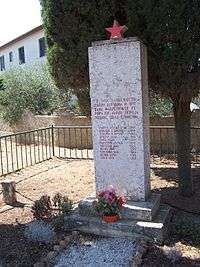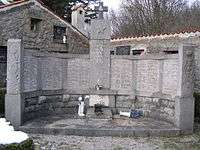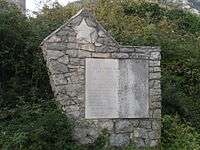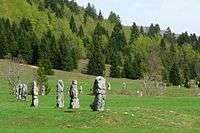List of Yugoslav World War II monuments and memorials in Croatia
List of Yugoslav World War II monuments and memorials in Croatia represent monuments and memorials built on the territory of the present day Croatia in Yugoslavia between 1945 and 1991. It does not include busts or other statues of individuals (see bottom).
History
The Yugoslav authorities established several memorial sites between 1945 and 1960, though widespread building started after the founding of the Non-Aligned Movement.
Yugoslav president Josip Broz Tito commissioned several memorial sites and monuments in the 1960s and 70s dedicated to World War II battle, and concentration camp sites. They were designed by notable sculptors, including Dušan Džamonja, Vojin Bakić, Miodrag Živković, Jordan and Iskra Grabul, and architects, including Bogdan Bogdanović, Gradimir Medaković. After Tito's death, a small number was built, and the monuments were popular visitor attractions in the 1980s as patriotic sites.
After the dissolution of Yugoslavia and during the Yugoslav Wars in the 1990s, World War II monuments and memorials were targeted and destroyed by vandals while the new Croatian government did nothing to prevent them. It is thought that more than 3000 antifascist memorials have been destroyed in Croatia since 1991. Today, the remaining memorial sites are visited by mostly local antifascist organisations and World War II veterans. In recent times, some demolished monuments were rebuilt.[1]
List
| Image | Name | Location | Notes |
|---|---|---|---|
 |
Monument to the Revolution of the people of Moslavina | Podgarić | Designed by Dušan Džamonja, built in 1967.[2] Dedicated to the people of Moslavina during World War II.[3] |
 |
Monument to the uprising of the people of Kordun and Banija | Petrova Gora | Designed by Vojin Bakić, built in 1981. Dedicated to the people of Kordun and Banija during World War II. |
 |
Borik Memorial Park | Bjelovar | Designed by Vojin Bakić, built in 1947. |
| |
Dudik Memorial Park | Vukovar | Designed by Bogdan Bogdanović, built from 1978 to 1980. |
 |
Batina Battle Memorial Complex | Batina | Designed by Antun Augustinčić, built from 1945 to 1947. Dedicated to fallen soldiers of Yugoslav and Red army during the Battle of Batina.[4] |
| |
Monument to fallen fighters and victims of fascism | Orebić | Located on the Pelješac peninsula, near the village called Gornje Pijavičino. Dedicated to 395 fallen Yugoslav partisans and civilians killed in Italian and ustasha concentration camps. Designed by Ivan Mitrović and Zlatko Jerić, built in 1983.[5] |
| |
Jasenovac Memorial Area | Jasenovac | Dedicated to concentration camp victims at the Jasenovac camp, held by the Ustasha. Designed by Bogdan Bogdanović, built in 1966.[6] |
 |
Monument to Sisak Detachment | Sisak | Designed by Želimir Janeš. Dedicated to the 1st Sisak Partisan Detachment. Built in 1981 on the site of establishment, in the forest of Brezovica.[7] |
| |
Monument of the Revolutionary victory of the people of Slavonia | Kamenska | Dedicated to the Partisan victory in Slavonia. Built in 1968 on the Blažuj hill.[8] It was once the biggest abstract sculpture in the world. The Croatian army destroyed the monument in 1992.[9] |
 |
Kamensko Monument | Kamensko | Abstract. Built in Bijeli potoci area of the Lika region. |
 |
Monument to fallen soldiers of the National Liberation War | Jelovice | |
 |
Monument to fallen fighters and victims of Fascist terror | Rovinj | Designed by Ivan Sabolić. Built in 1956. |
 |
Monument to fallen fighters | Trpinja | |
 |
Monument to fallen fighters | Bobota | Built in 1955. |
 |
Monument to fallen fighters | Đurđevac | Designed by Slavko Šoša, built in 1952. |
 |
Peroj | ||
| |
Monument to the uprising of the people of Croatia in 1941 | Srb | Designed by Vanja Radauš; built in 1951,[10] destroyed in 1995, reconstructed in 2010, reopened in 2011. Dedicated to the antifascist uprising of the local people at 27 July 1941, which quickly spread to whole of Lika and Bosanska Krajina. |
 |
Memorial to victims of fascism killed in Dotršćina | Zagreb | Designed by Vojin Bakić; built in 1968.[11] Dedicated to cca. 10,000 victims of fascism killed by Ustasha in the Dotršćina forest from 1941 to 1945. |
| |
Monument to the Battle of Bolman | Bolman | Designed by Nikola Kečanin; built in 1951. Dedicated to fallen fighters of Yugoslav and Red army in the battle of Bolman in 1944. |
 |
Shooting of hostages | Zagreb | Designed by Frano Kršinić; built in 1951.[12] Dedicated to victims of fascism killed by the Ustasha in Dotršćina, Maksimir and Rakov Potok near Zagreb 1941-1945. |
 |
Monument to victims of fascism from Podhum | Platak | Designed by Šime Vulas; built in 1970.[13] Dedicated to residents of Podhum village, who were all killed by Italian fascists in 1942. |
 |
Monument to fallen fighters and victims of fascism | Pula | Designed by Vanja Radauš; built in 1950. |
 |
Memorial to the liberation of Rijeka | Rijeka | Designed by Vinko Matković; built in 1955. |
| |
Tomb of the People's Heroes | Zagreb | Designed by Đuro Kaurić; built in 1968. |
 |
Monument to the residents of Zagreb fallen in People's liberation struggle 1941-45 | Zagreb | Designed by Stevan Luketić; built in 1981. |
 |
Monument to fallen fighters | Zagreb | Designed by Tomislav Ostoja, built in 1972.[14] |
 |
Monument to fallen fighters | Viškovo | |
 |
Monument to freedom | Donji Miholjac | Designed by Stjepan Brlošić, built in 1968. Dedicated to fallen fighters and victims of fascism from Donji Miholjac and neighbouring places. |
 |
Monument to fallen fighters | Crikvenica | Designed by Zvonko Car, built in 1949. |
 |
Monument to fallen fighters | Dramalj | Designed by Zvonko Car. |
 |
Monument to the December victims of 1943 | Zagreb | Designed by Dušan Džamonja, built in 1961.[15] Dedicated to 16 antifascists that were hung by Ustasha in Dubrava on 20 December 1943. |
| |
Monument to fallen fighters | Slavonski Brod | |
 |
Monument to the children from the Kozara mountain | Zagreb | Designed by Stevan Luketić. Dedicated to more than 400 children that were taken from the Kozara mountain by Ustasha in 1942, and after that confined in many concentration camps (Jasenovac, Lepoglava, Jastrebarsko, etc.) where most of them died.[16] |
 |
Monument to fallen fighters | Šolta | |
 |
Monument to fallen fighters | Kraljevica | |
 |
Monument to fallen fighters | Drivenik | |
 |
Monument to victims of fascism | Lipa | Dedicated to 269 people killed by Italian fascists and German nazists on 30.04.1944. |
| |
Monument to fallen fighters | Lovište | |
| |
Monument to fallen fighters and victims of fascism | Kuna Peliška | |
| |
Monument to victims of fascism | Pijavičino | |
| |
Monument to fallen fighters | Viganj | |
| |
Monument to fallen fighters and victims of fascism | Ploče | |
 |
Monument to fallen fighters | Ston | |
| |
Monument “Seagull's wings” | Podgora | Designed by Rajko Radović, built in 1962.[17] Dedicated to the foundation of the Yugoslav partisan navy in 1942. |
| |
Monument to fallen fighters and victims of fascism | Vodice | |
 |
Monument to fallen fighters and victims of fascism in Zagreb 1941-45 | Zagreb | Designed by Branko Ružić. |
 |
Monument to fallen fighters and victims of fascism from Slabinja | Slabinja | Built in 1981. |
 |
Monument to fallen fighters | Dabar | |
| |
Monument to fallen fighters | Novi Vinodolski | |
| |
Monument to railway workers fallen in People's liberation struggle | Rijeka | |
 |
Monument “Three seamen” | Senj | Dedicated to fallen partisan fighters 1941-45. |
 |
Monument to the uprising | Near Sisak | Designed by Frano Kršinić, built in 1954. Slightly damaged. |
 |
Monument to the liberation of Zagreb | Pleso | Designed by Marijan Burger, built in 1978. Dedicated to the breaking of Ustaša and German defense circle around Zagreb by Yugoslav army units in 1945.[18] |
| |
Monument to fallen fighters | Virovitica | Designed by Dušan Džamonja. |
 |
Monument to fallen fighters | Bobota | |
 |
Monument to fallen fighters | Županje Selo | |
| |
Monument to fallen fighters | Povile | Built in 1981. |
| |
Monument to fallen fighters | Orebić | |
 |
Monument to fallen fighters | Kaniža | |
| |
Monument to fallen fighters | Zagreb | Dedicated to fallen fighters of Jarun and Staglišće. |
| |
Monument to fallen fighters and victims of fascism | Slatina | Dedicated to 2500 fallen partisan fighters and 6500 victims of fascism from Slatina and neighbouring places. |
| |
Monument to fallen fighters | Bolman | Dedicated to fallen fighters in the battle of Bolman. |
| |
“The Carrying of the Wounded” | Zagreb | Designed by Antun Augustinčić, built in 1953. Dedicated to the students of Faculty of Veterinary Medicine in Zagreb who have fallen in struggle against fascism.[19] |
 |
Monument to the Uprising | Drežnica | Designed by Kosta Angeli Radovani, built in 1949.[20] Dedicated to fallen fighters and victims of fascism from Drežnica. |
 |
Šubićevac Memorial Park | Šibenik | Designed by Kosta Angeli Radovani and Zdenko Kolacio, built in 1961.[21] Dedicated to 43 victims who were executed by Italian fascists from 1941 to 1943. |
| |
Monument to fallen fighters | Samobor | Designed by Nikola Njirić. |
| |
Monument to fallen fighters | Kumrovec | |
| |
Monument to victims of fascism | Krapinske Toplice | Designed by Antun Augustinčić, built in 1973. Until the 1990s, at the memorial plaque on the monument was writing In the honor of the victims of fascism. After that, it was added ...and of the Homeland war. Partisan star was also replaced by the Coat of arms of Croatia. |
| |
Monument to fallen fighters | Zagreb | Designed by Vanja Radauš. |
| |
Monument to fallen fighters | Zagreb | Built in 1961. |
| |
Monument to fallen fighters | Gaboš | |
| |
Memorial water well to Kosta Rakin, Jasenovac concentration camp victim | Markušica | Built in 1970. |
| |
Monument to fallen fighters | Markušica | |
| |
Monument to fallen fighters | Ostrovo | |
| |
Partisan cemetery | Komletinci | Designed by Zdenko Kolacio and Dušan Džamonja, built in 1976. |
 |
Kampor Memorial Park | Rab | Designed by Edvard Ravnikar and Vladimir Lakovič, built in intervals between 1953 and 1988. |
| |
Tičan Memorial Area | Tičan | Built in 1965. |
 |
26 Frozen Partisan Fighters Memorial | Matić poljana | Designed by Zdenko Sila. |
| |
Red Army Memorial | Beli Manastir | |
 |
Monument to fallen fighters and victims of fascism | Plovanija | Designed by Aleksandar Rukavina, built in 1981. |
| |
Monument to fallen fighters and victims of fascism | Tordinci |
See also
| Wikimedia Commons has media related to World War II memorials in Croatia. |
- People's Heroes of Yugoslavia monuments
- List of World War II monuments and memorials in Bosnia and Herzegovina
- List of World War II monuments and memorials in Montenegro
- List of World War II monuments and memorials in Serbia
- List of World War II monuments and memorials in Slovenia
- List of World War II monuments and memorials in the Republic of Macedonia
- List of Yugoslav World War II monuments and memorials
References
- ↑ Hina (30 March 2014). "Razaranje jugoslavenske kulture". Retrieved 11 June 2016.
- ↑ "Spomeniks: the second world war memorials that look like alien art". The Guardian newspaper. Retrieved 28 April 2014.
- ↑ Zdunić, Drago, ed. "Revolucionarno kiparstvo", Zagreb: Spektar, 1977, p. 174
- ↑ Zdunić, Drago, ed. "Revolucionarno kiparstvo", Zagreb: Spektar, 1977, p. 102
- ↑ "Rušenje antifašističkih spomenika 1990-2000", Zagreb: SABARH, 2002, p. 53
- ↑ Zdunić, Drago, ed. "Revolucionarno kiparstvo", Zagreb: Spektar, 1977, p. 106
- ↑ "Rušenje antifašističkih spomenika 1990-2000", Zagreb:SABARH, 2002, p. 204
- ↑ Zdunić, Drago, ed. "Revolucionarno kiparstvo", Zagreb: Spektar, 1977, p. 109
- ↑ "Rušenje antifašističkih spomenika 1990-2000", Zagreb: SABARH, 2002, p. 164
- ↑ Zdunić, Drago, ed. "Revolucionarno kiparstvo", Zagreb: Spektar, 1977, p. 82.
- ↑ Zdunić, Drago, ed. "Revolucionarno kiparstvo", Zagreb: Spektar, 1977, p. 108
- ↑ Zdunić, Drago, ed. "Revolucionarno kiparstvo", Zagreb: Spektar, 1977, p. 92-94
- ↑ Zdunić, Drago, ed. "Revolucionarno kiparstvo", Zagreb: Spektar, 1977, p. 166
- ↑ Zdunić, Drago, ed. "Revolucionarno kiparstvo", Zagreb: Spektar, 1977, p. 105
- ↑ Zdunić, Drago, ed. "Revolucionarno kiparstvo", Zagreb: Spektar, 1977, p. 135
- ↑ Ugarković, Stipe & Očak, Ivan, "Zagreb grad heroj: spomen obilježja revoluciji", Zagreb: August Cesarec, 1979, p. 189
- ↑ Zdunić, Drago, ed. "Revolucionarno kiparstvo", Zagreb: Spektar, 1977, p. 111
- ↑ Ugarković, Stipe & Očak, Ivan, "Zagreb grad heroj: spomen obilježja revoluciji", Zagreb: August Cesarec, 1979, p. 246
- ↑ Ugarković, Stipe & Očak, Ivan. "Zagreb grad heroj: spomen obilježja revoluciji", Zagreb: August Cesarec, 1979, p. 252-253
- ↑ Zdunić, Drago, ed. "Revolucionarno kiparstvo", Zagreb: Spektar, 1977, p. 73-74
- ↑ Zdunić, Drago, ed. "Revolucionarno kiparstvo", Zagreb: Spektar, 1977, p. 110